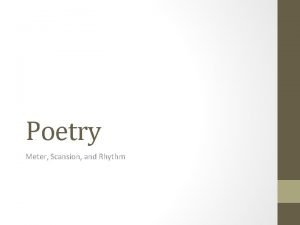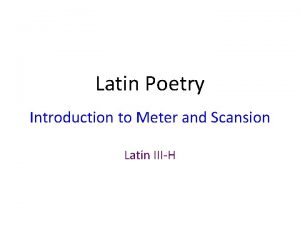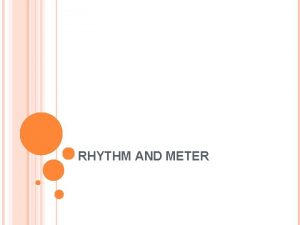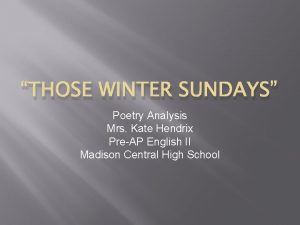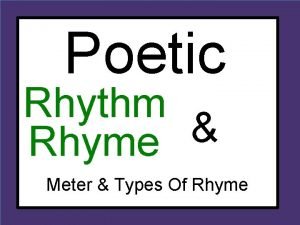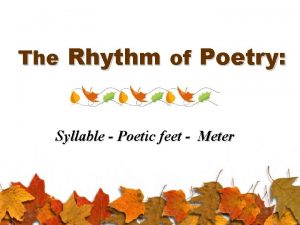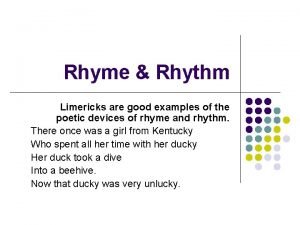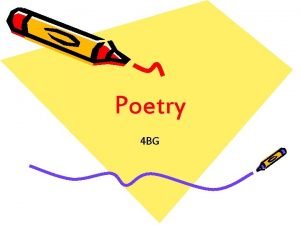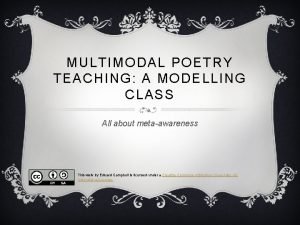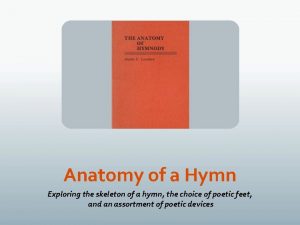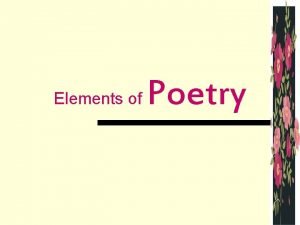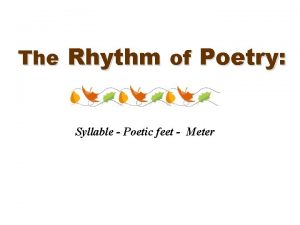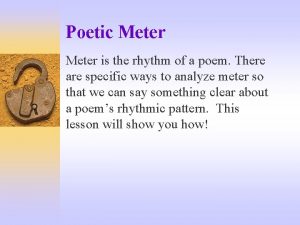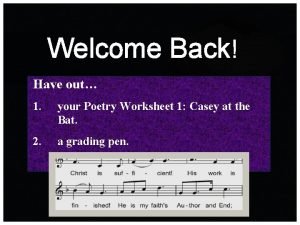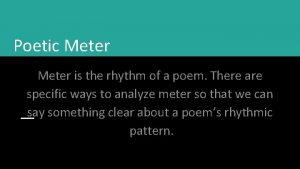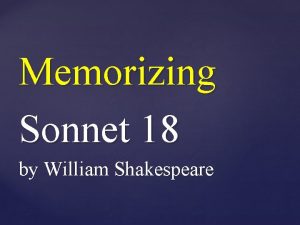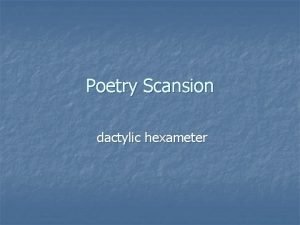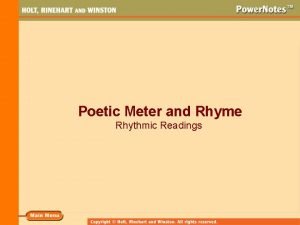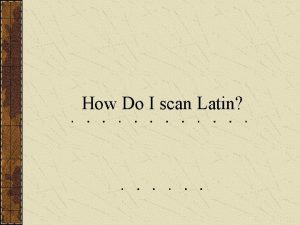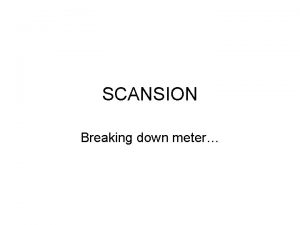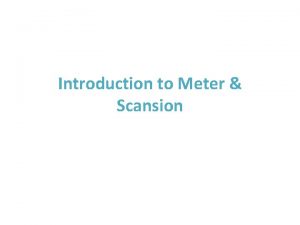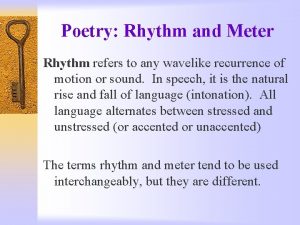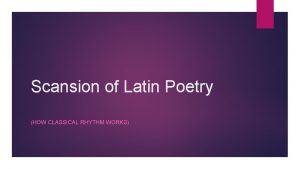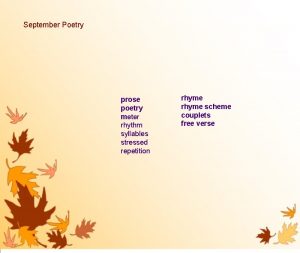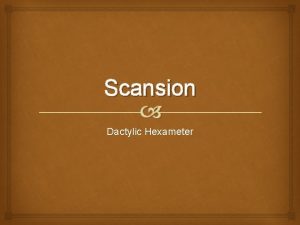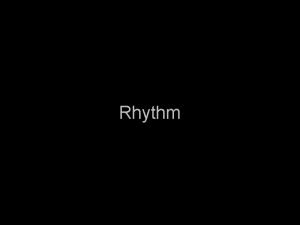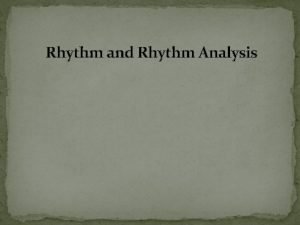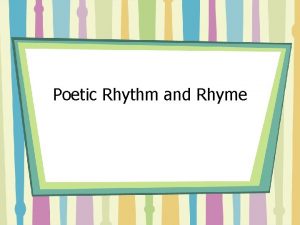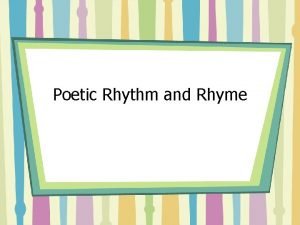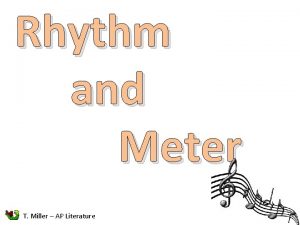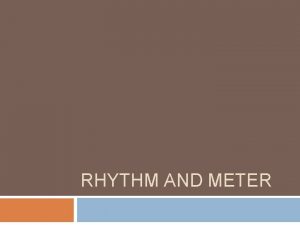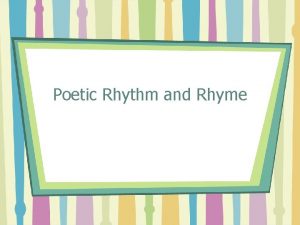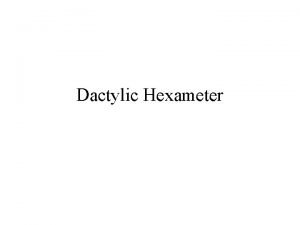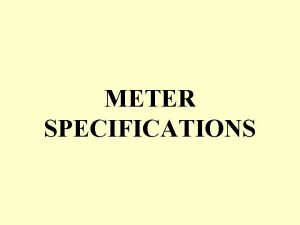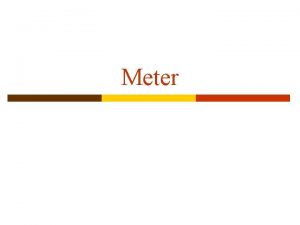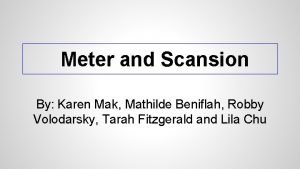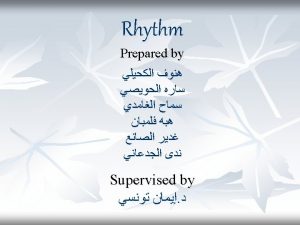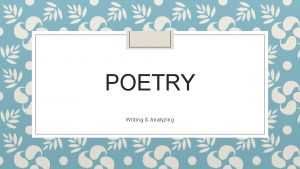Analyzing Rhythm Meter in Poetry SCANSION Jennifer A























- Slides: 23

Analyzing Rhythm & Meter in Poetry SCANSION Jennifer A. Bennett Sanderson High School Raleigh, North Carolina Wake County Public School System

Common Vocabulary Syllabification: dividing a word into its syllables (each syllable has its own beat) � Scansion: analyzing and marking the stressed ( ) and unstressed ( ) syllables of the words in the lines of a poem to determine the pattern of foot and meter � Rhythm: the pattern of beats created by the stressed ( ) and unstressed ( ) syllables of the words in the lines of a poem � Foot: the smallest unit of rhythm in a line of poetry � Meter: measuring the number of feet in a line of poetry �

Scansion � 1. Steps: Mark every syllable to determine whether each is stressed or unstressed. The stressed and unstressed beats in polysyllabic words are already set—they don’t change. Whether a monosyllabic word is stressed or not depends on the rhythmic pattern created by the other words surrounding it. 2. Identify any rhythmic pattern—look for the repetition of a poetic foot. Ex. "And the sheen of their spears was like stars on the sea” Repeated foot: [ 3. ] Count the number of feet in each line to determine meter. [ ]x 4

The Poetic Foot � Foot: �The smallest unit of measurement in a line of poetry �Made up of given combinations of stressed and unstressed beats �Repetition of a foot creates a regular rhythm

Iambs & Trochees � Iamb (n) / iambic (adj) foot �u|nite �de|pend �be|neath � Trochee �tro|chee �rea|per �tea|cher (n) / trochaic (adj) foot

Anapests & Dactyls � Anapest (n) / anapestic (adj) foot �to the dance �not a chance �in between � Dactyl (n) / dactylic (adj) foot �yes|ter|day �hap|pi|ly

Spondee � sounds like. . .

Spondees & Dibrachs � Spondee (n) / spondaic (adj) foot �Two house|holds �Who’s there? �Fe, Fi, Fo, Fum! � Dibrach (aka: pyrrhic foot) �"When the blood creeps and the nerves prick” �"To a green thought in a green shade"

Meter: the number of feet in a line � one foot = monometer Foo t Mete r �Ex. one trochee in a line = trochaic monometer � two feet = dimeter �Ex. two dactyls in a line = dactylic dimeter � three feet = trimeter �Ex. three anapests in a line = anapestic trimeter � four feet = tetrameter �Ex. four dactyls in a line = dactylic tetrameter � five feet = pentameter �Ex. five iambs in a line = iambic pentameter � six feet = hexameter �Ex. six trochees in a line = trochaic hexameter


Scan the following lines, and identify the pattern: TIGER, tiger, burning bright In the forests of the night, What immortal hand or eye Could frame thy fearful symmetry?

So What? (What are the effects? ) TIGER, tiger, burning bright In the forests of the night, What immortal hand or eye Could frame thy fearful symmetry?

Iambic Pentameter But soft! What light through yonder window breaks? It is the East, and Juliet is the sun. . . . . From forth the fatal loins of these two foes A pair of star-crossed lovers takes their life.

More Fair is foul, and foul is fair. Hover through the fog and filthy air. ~~~~~~~~~~~ Double, double, toil and trouble, Fire burn and cauldron bubble.

Stanza Division � Couplet: two lines �Heroic Couplet: two rhyming lines of iambic pentameter � Tercet: three lines � Quatrain: four lines � Quintain: five lines � Sestet: six lines � Septet: seven lines � Octave: eight lines

More Common Vocabulary Structure: any element in a poem that creates form, that organizes the words and ideas in a poem, including line breaks, rhythm, rhyme, syntax, tone shifts, etc. � Open Form: (a. k. a. “free verse”) poetry that does not follow a regular or prescribed pattern of rhyme, rhythm, meter, line or stanza length; relies more on the rhythms of natural speech � Closed Form: poetry that does follow a regular or prescribed pattern (ex. sonnets, sestinas, haikus, limericks, villanelles, �

The Ballad � Narrative poetry (tells a story) �Remember the three genres of poetry? ○ Lyric ○ Dramatic ○ Narrative � Origins: � English and Scottish folk ballads � First appeared during 12 th century—written to reflect Scottish dialect � Passed on through oral tradition for centuries � “Songs of the People”

Ballad Description � Presents a single dramatic episode/event � Told through action and dialogue � Little characterization, description, or motivation � Contains a refrain: repeated line or stanza � Meant to be sung

Ballad Structure (Closed form) � Closed form poem: a poem with specifically prescribed elements (such as rhyme, meter, stanza division, etc. ) � Consists of four-lined stanzas (quatrains), � Conventional rhyme scheme: abcb or abab � Rhythm: �Lines 1 & 3: iambic tetrameter �Lines 2 & 4: iambic trimeter

The Sonnet

The Villanelle

The Sestina

The Haiku
 Meter and scansion
Meter and scansion Meter and scansion calculator
Meter and scansion calculator Scansion rules latin
Scansion rules latin Rhyme scheme and meter
Rhyme scheme and meter Gambar tekanan zat padat
Gambar tekanan zat padat Analyzing poetry those winter sundays answers
Analyzing poetry those winter sundays answers Examples of rhymes in poems
Examples of rhymes in poems Meter and feet in poetry
Meter and feet in poetry Irony figure of speech
Irony figure of speech Internal rhythm examples
Internal rhythm examples Rhyming pattern
Rhyming pattern A poem for my mother by jennifer davids analysis
A poem for my mother by jennifer davids analysis Common meter in poetry
Common meter in poetry The word plum by helen chasin
The word plum by helen chasin 1 stressed syllable followed by 1 unstressed syllable
1 stressed syllable followed by 1 unstressed syllable Poetic meter
Poetic meter Poetry meter worksheet
Poetry meter worksheet Poem metrical pattern
Poem metrical pattern Examples of foot
Examples of foot Shall i compare thee to a summer's day romeo and juliet
Shall i compare thee to a summer's day romeo and juliet Dactylic hexameter example
Dactylic hexameter example Scan poem calculator
Scan poem calculator To a skylark scansion
To a skylark scansion Fugiant latin
Fugiant latin
